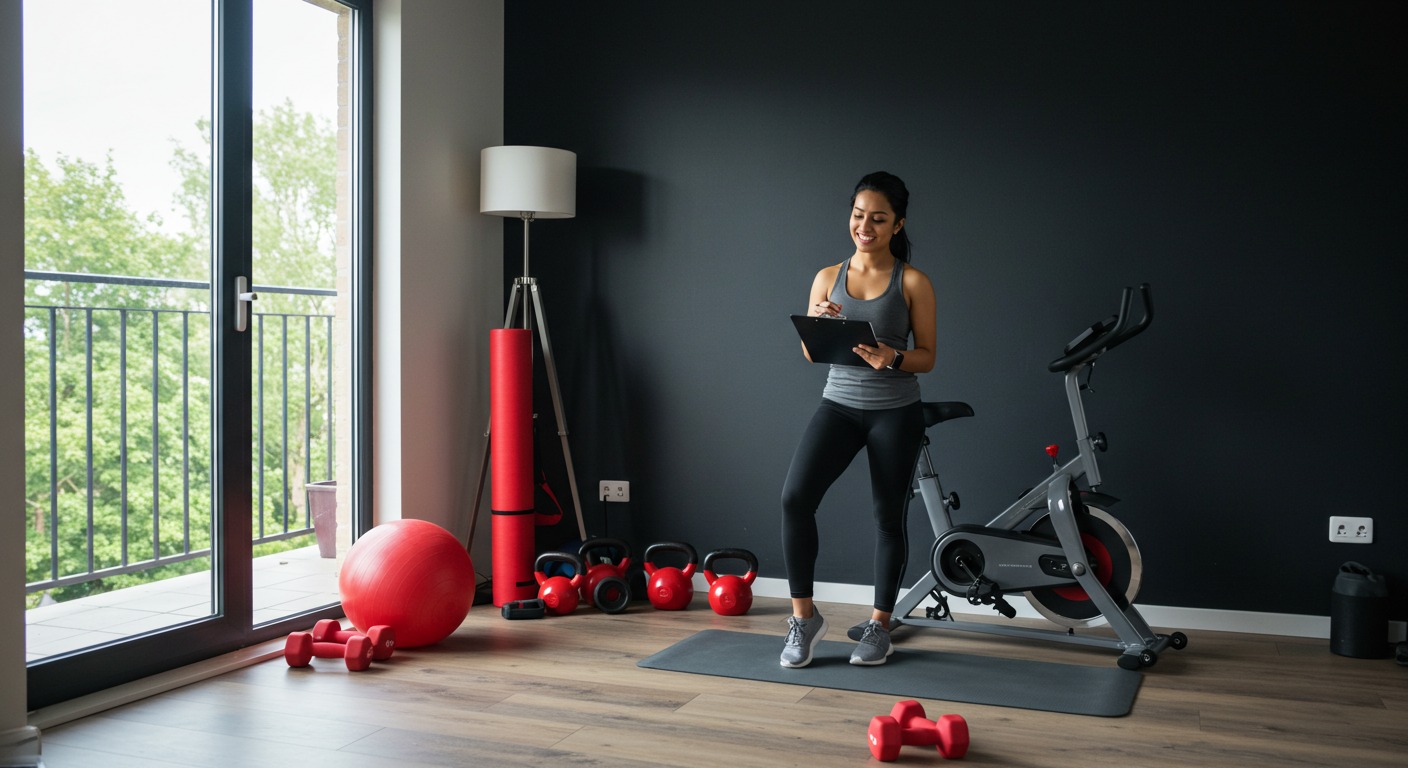Disclosure Information
This blog contains affiliate links. If you make a purchase through one of these links, our team may earn a commission at no extra cost to you. Learn more. Thanks for your support!
If you’re serious about building strength at home, a power rack should be at the top of your equipment list. It’s the cornerstone of a functional home gym—offering unmatched versatility, safety, and support for everything from squats and bench presses to pull-ups and accessory work.
But not all power racks are created equal. With so many sizes, features, and price points available, finding the one that fits your space, goals, and budget can be a challenge. That’s where this guide comes in.
We’ll walk you through the essentials—what to look for, what to avoid, and how to choose the perfect rack for your setup.
The Quick Overview: Best Power Racks Mentioned
- Best Customizable Full Cage: Rep Fitness PR-4000 Power Rack
- Best Robust Half Rack: Rogue HR-2 Half Rack
- Best Budget Squat Stand: Titan Fitness T-3 Series Squat Stand
- Best Space-Saving Folding Rack: PRx Performance Profile ONE Rack
What is a Power Rack and Why Do You Need One?
A power rack is essentially a steel cage designed for safe barbell exercises. It typically consists of four vertical posts connected by horizontal bars, creating a stable frame. Key components include J-hooks to hold the barbell and adjustable safety bars (or straps) to catch the weight if you fail a lift.
Why is this a cornerstone for serious home training? Safety. When lifting heavy weights alone, the safety bars act as your virtual spotter. This allows you to push your limits confidently during exercises like squats and bench presses.
Beyond safety, power racks offer incredible versatility. They are the central hub for numerous strength-building exercises. This makes them an essential investment for anyone serious about getting stronger at home.
The rise of home fitness setups underscores this need for reliable equipment. In fact, the global home fitness equipment market is projected to continue its significant growth.
Key Benefits of Owning a Power Rack
Investing in a power rack brings significant advantages to your home gym:
- Unmatched Safety: Train heavy without a human spotter. The safety pins or straps provide a crucial safety net. This confidence allows for better focus on form and effort.
- Exercise Versatility: Perform foundational compound lifts like squats, bench presses, overhead presses, and rack pulls. Many racks also include pull-up bars. Add attachments, and the possibilities expand further.
- Supports Progressive Overload: Safely adding weight over time is key to strength gains. A power rack handles heavy loads, allowing you to consistently challenge yourself and progress.
- Long-Term Investment: A quality power rack is built to last for decades. It’s a durable piece of equipment that forms the core of your strength training journey.
- Space Efficiency (Relatively): While large, a rack consolidates multiple exercise stations into one footprint. It’s often more space-efficient than several single-purpose machines.
Types of Power Racks (and Top Recommendations)
Not all racks are created equal. They vary in design, footprint, features, and cost. Understanding these differences is key to choosing the perfect fit for your space, budget, and training goals. This is the heart of your decision-making process.
1. Full Power Cages (4-Post Racks)
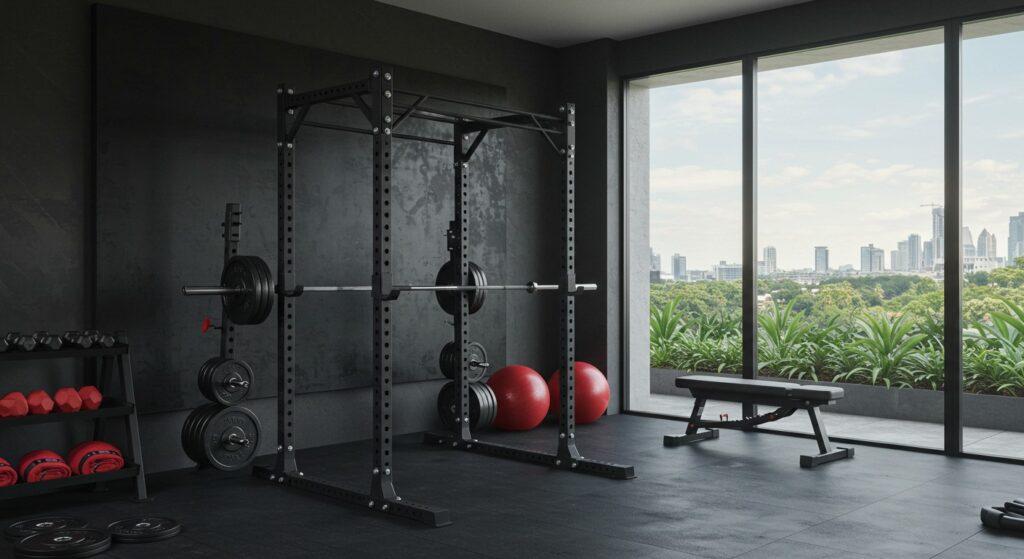
This is the classic power rack design. Four vertical posts create a fully enclosed cage, offering maximum stability and safety. Lifters operate inside the cage.
| Feature | Pro | Con |
| Design | Maximum Stability | Largest Footprint |
| Safety | Highest Level | Can Feel Confining |
| Attachments | Widest Compatibility | Often Higher Cost |
| Ideal User | Serious Lifters | Needs Dedicated Space |
| Weight Capacity | Typically Very High | More Complex Assembly |
Who is it for? Lifters prioritizing maximum safety, lifting heavy weights, and having ample dedicated space. Those planning extensive use of attachments benefit greatly.
Product Spotlight: Rep Fitness PR-4000 Power Rack
A popular choice known for customization. Features 3×3″ 11-gauge steel uprights. Offers numerous color options and attachment compatibility. Ideal for serious home gym builders.
Check it out on RepFitness
2. Half Racks (2-Post Racks)
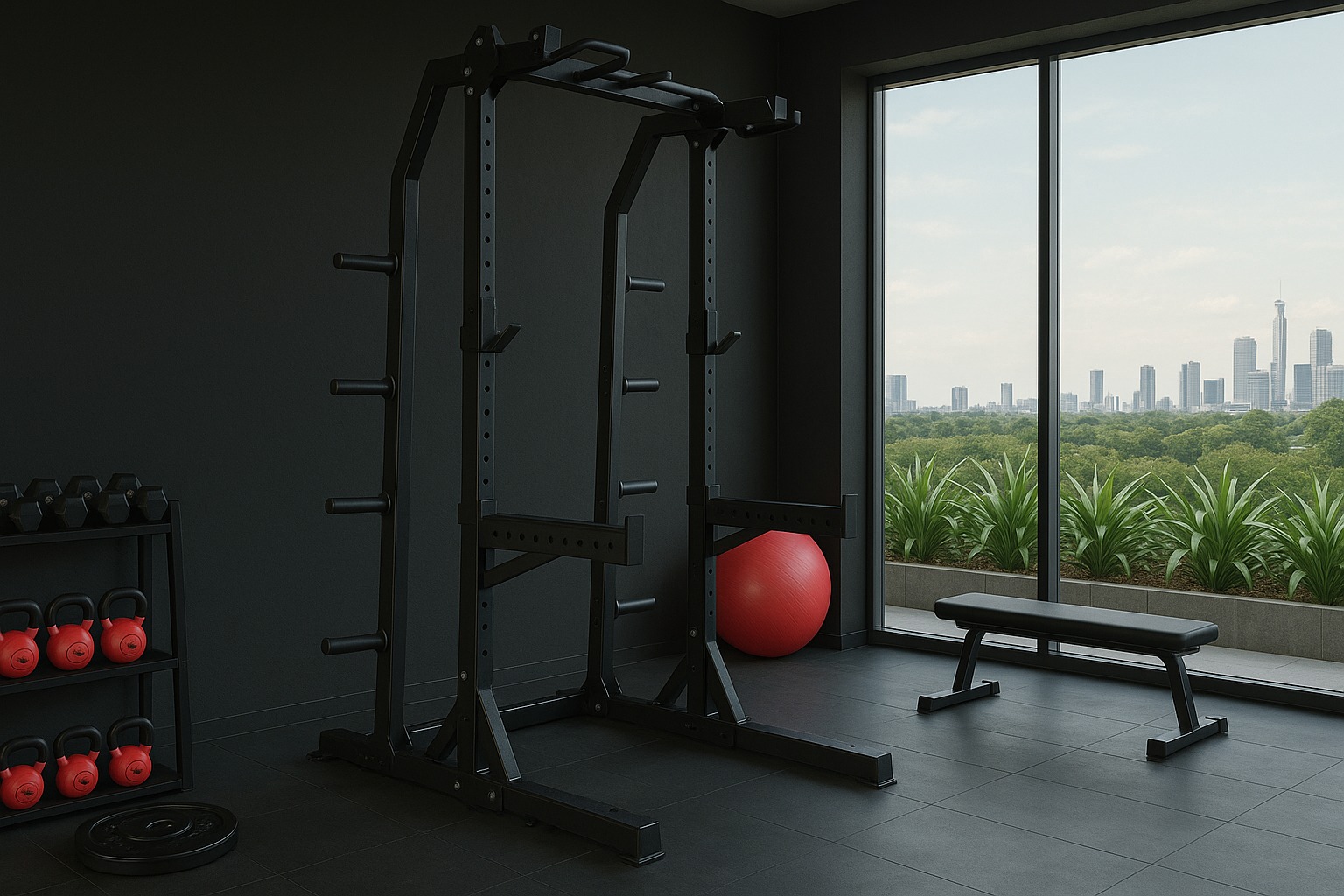
Half racks feature two main uprights connected by base and top stabilizers, sometimes with rear weight storage posts. They offer an open design, meaning you lift in front of the rack, not inside.
| Feature | Pro | Con |
| Design | More Open Feel | Less Stable Than Cage |
| Safety | Good (with spotter arms) | Safeties Extend Outward |
| Footprint | Smaller Than Full Cage | Fewer Inside-Rack Options |
| Ideal User | Space-Conscious Lifters | May Need Bolting Down |
| Accessibility | Easier Barbell Movement | Attachment Options Vary |
Who is it for? Lifters with moderate space constraints who prefer an open lifting area. Suitable for heavy lifting, provided it’s stable (bolting down is often recommended).
Product Spotlight: Rogue HR-2 Half Rack
A robust option from a well-regarded brand. Features 3×3″ 11-gauge steel. Includes essential safety arms and J-cups. Offers good stability and attachment potential for its size.
Check it out on RogueFitness
3. Squat Stands
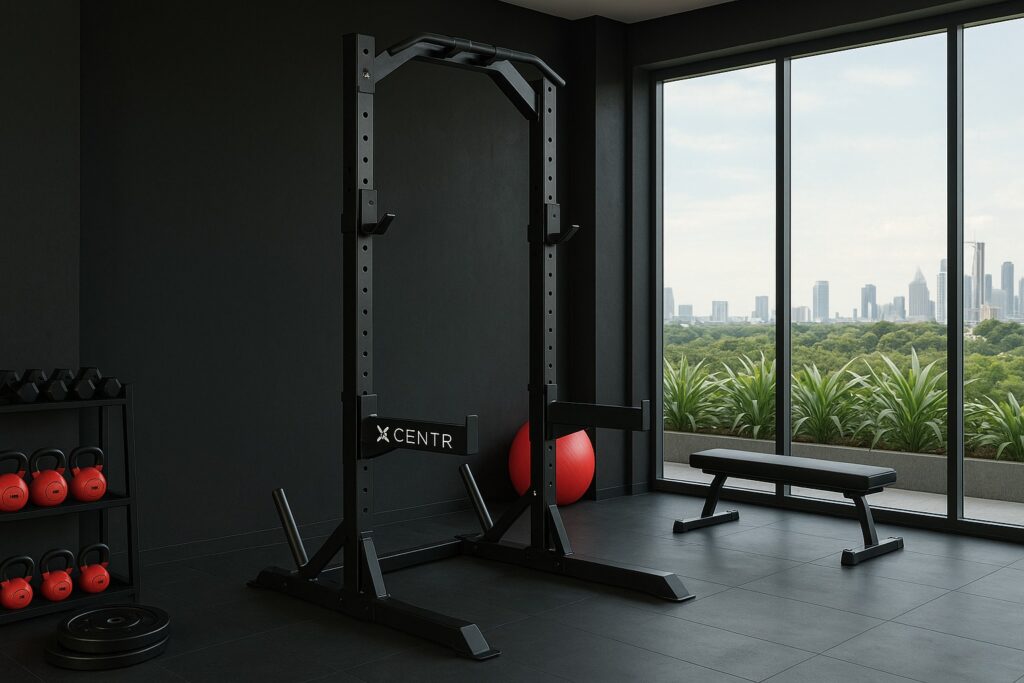
The simplest option, squat stands consist of two independent vertical posts or two posts connected by a base. They primarily support squats and presses but offer less safety and versatility.
| Feature | Pro | Con |
| Design | Most Compact | Least Stable |
| Safety | Basic (Adjustable J-Hooks) | Limited Safety Features |
| Footprint | Smallest / Portable | Lower Weight Capacity |
| Ideal User | Beginners / Budget Focus | Not Ideal For Max Lifts |
| Cost | Most Affordable | Minimal Versatility |
Who is it for? Beginners, those on a tight budget, or lifters with extremely limited space who primarily need support for squats and bench presses. Safety arms are a highly recommended add-on if available.
Product Spotlight: Titan Fitness T-3 Series Squat Stand
A budget-friendly yet sturdy stand. Features 2×3″ 11-gauge steel. Offers adjustable J-hooks and optional spotter arms. Good entry point for basic barbell work.
Check it out on Amazon
4. Folding Racks (Wall-Mounted)
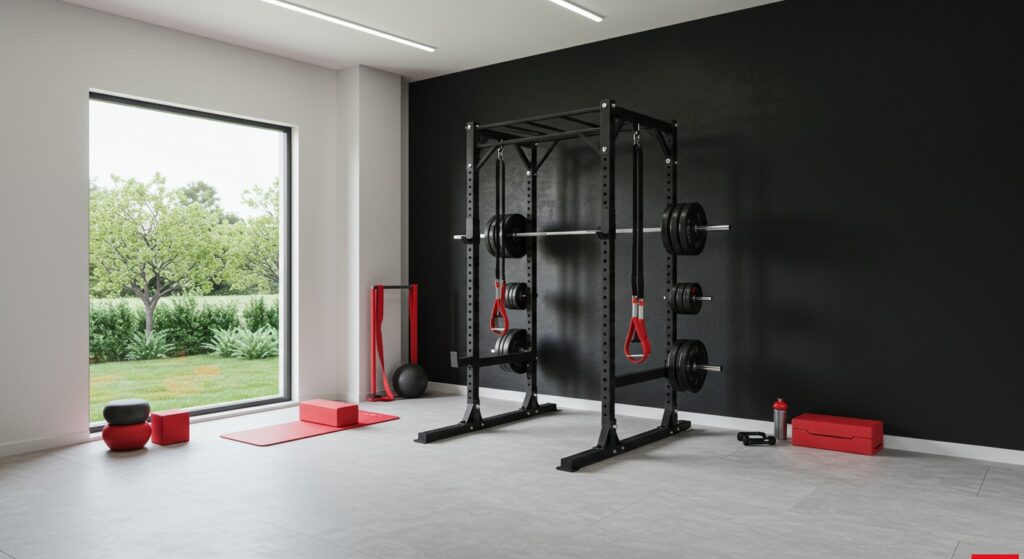
These innovative racks attach to your wall studs. They feature hinged uprights that swing inward or outward, folding nearly flat against the wall when not in use.
| Feature | Pro | Con |
| Design | Ultimate Space Saving | Requires Wall Installation |
| Footprint | Minimal When Folded | Needs Strong Wall Studs |
| Stability | Surprisingly Good | Potential Wall Damage Risk |
| Ideal User | Very Limited Space | DIY Installation Skills |
| Versatility | Good (includes pull-up) | Attachment Limits |
Who is it for? Home gym owners in multi-use spaces like garages or spare rooms where floor space is premium. Requires sturdy wall construction for safe mounting.
Product Spotlight: PRx Performance Profile ONE Rack
Famous for its ease of folding. Gas shocks assist lifting/lowering. Offers various depths and configurations. A premium space-saving solution demanding proper installation.
Check it out on Amazon
5. Combo Racks & Functional Trainers
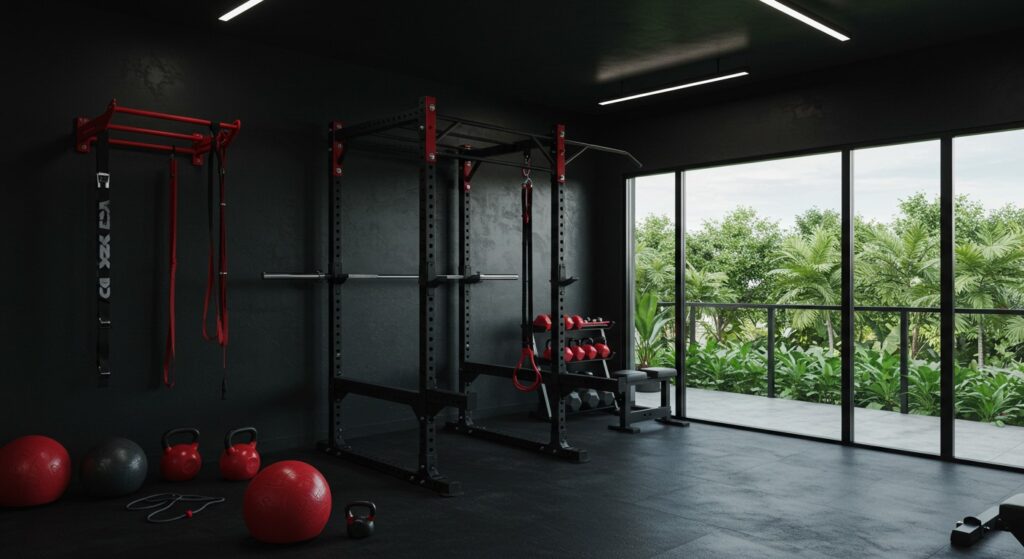
Some high-end units combine a power rack with other gym machines. This often includes integrated lat pulldown / low row stations or even full cable crossover systems (functional trainers).
These are versatile but come at a significantly higher cost and footprint. They represent the ultimate all-in-one home gym solution for some.
Key Factors to Consider Before Buying Your Power Rack
Choosing the right type is step one. Now, let’s drill down into the specifics to ensure your chosen rack meets your needs precisely.
Space and Ceiling Height
Measure your available space meticulously: width, depth, and height. Account for the rack’s footprint, plus clearance for loading weight plates and performing exercises (like overhead presses). Ceiling height is critical, especially if you plan on doing pull-ups inside the rack. Low ceilings might necessitate a shorter rack or squat stand.
Budget
Power rack prices vary widely. Squat stands can start under $300, while high-end full cages with attachments can exceed $2000. Set a realistic budget, considering that a rack is a long-term safety investment. Factor in potential shipping costs, which can be substantial for heavy items.
Weight Capacity
Consider your current strength and future goals. Most racks list a weight capacity (e.g., 700 lbs, 1000 lbs, 1500+ lbs). Choose a rack rated significantly higher than your current maximum lifts to allow room for progression.
For reference, while elite powerlifters squat incredible amounts, many recreational lifters build significant strength within the 300-500 lb range. Ensure the J-hook and safety bar capacity also meet your needs.
Steel Gauge and Tubing Size
These specs indicate the rack’s sturdiness:
- Steel Gauge: Lower numbers mean thicker steel (e.g., 11-gauge is thicker and stronger than 14-gauge). For serious lifting, 11-gauge is often recommended. 12-gauge can be sufficient for moderate use.
- Tubing Size: Refers to the dimensions of the vertical posts (e.g., 2×2″, 2×3″, 3×3″). Larger tubing generally means a more robust and stable rack, especially 3×3″, which is common in commercial and high-end home racks.
Hole Spacing (Westside vs. Standard)
The distance between adjustment holes on the uprights matters. “Westside” spacing features 1-inch spacing through the bench press zone, allowing for precise safety bar and J-hook placement.
Standard spacing is typically 2 inches throughout. Westside spacing is beneficial for optimizing bench press setup.
Attachments and Compatibility
Think about future expansion. Do you want dip bars, a landmine attachment, multi-grip pull-up bars, or plate storage? Check the compatibility of attachments with the rack’s tubing size and hole diameter (commonly 5/8″ or 1″).
Choosing a rack within a larger ecosystem (like Rogue Monster Lite or Rep PR-4000/5000) offers more future options.
Assembly
Power racks require assembly. Some are straightforward, others more complex. Check reviews or instructions beforehand. You’ll need basic tools (wrenches, sockets). Consider if you’re comfortable with DIY assembly or might need help. Bolting the rack to the floor (or a platform) is often recommended for maximum stability, especially for half racks.
Essential Power Rack Attachments
While the basic rack is functional, attachments unlock its full potential:
- J-Hooks/J-Cups: Standard for holding the barbell. Upgraded versions might have better protective lining.
- Safety Arms/Straps: Crucial for safety. Pins/pipes are standard; straps are quieter and gentler on barbells. Ensure they are easily adjustable.
- Pull-Up Bar: Most racks include one. Options range from a simple straight bar to multi-grip bars offering various hand positions.
- Dip Station: Attaches to the uprights for effective triceps and chest work.
- Landmine Attachment: A sleeve that holds one end of a barbell for rotational exercises, rows, and presses.
- Weight Plate Storage Pegs: Keep your weight plates organized and add stability to the rack.
- (Optional) Lat Pulldown/Low Row: Integrated or add-on systems for back training versatility.
Safety First: Using Your Power Rack Correctly
Owning a rack is step one; using it safely is paramount.
- Set Safeties Correctly: For squats, set them just below the bar’s lowest point in your range of motion. For bench press, set them slightly above your chest when arched. Always test with an empty bar first.
- Check Stability: Regularly inspect bolts and ensure the rack isn’t wobbling. Bolting down enhances safety significantly.
- Master Proper Lifting Form: A rack provides safety, but good lifting form prevents injuries. Learn correct technique before lifting heavy. Consider hiring a coach initially. Lifting-related injuries are common. Proper form and equipment are key preventative measures.
- Know Your Limits: Don’t ego lift. Progress gradually and listen to your body.
Integrating Your Power Rack into Your Home Gym
Your power rack is the centerpiece, but it needs companions:
- Barbell: A quality Olympic barbell is essential.
- Weight Plates: Start with a basic set and add more as you get stronger. Bumper plates are ideal if you plan on doing Olympic lifts or want quieter operation.
- Adjustable Bench: Necessary for bench presses, incline presses, seated presses, and other exercises.
- Flooring: Protect your floor and equipment with rubber gym flooring (stall mats or specialized tiles). This also improves stability and absorbs impact.
Conclusion
A power rack is more than just steel; it’s an investment in your strength, safety, and long-term fitness journey. It provides the secure environment needed to push your boundaries and achieve results you might not have thought possible at home.
By understanding the different types, considering key factors like space and budget, and prioritizing safety, you can choose the perfect power rack. This cornerstone piece will empower you to train smarter and build a truly limitless home fitness experience.
Explore your options, choose wisely, and get ready to lift!



